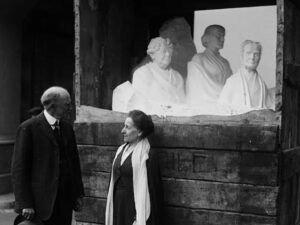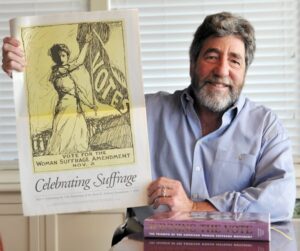Robert P.J. Cooney, Jr., a Wild West Women Board member, is also on the board of the Monuments Council of Advisors.
Read more about Bob here.
The end of a presidency tends to bring a rush of last-minute monument making, and Joe Biden’s was no different. In his final week in office, he designated nearly 850,000 acres of federal land in California as two new national monuments.
Biden, headlines noted, had protected more land than any president in history — some 674 million acres. But amid all the fanfare, another piece of news out of the White House passed with little notice: the signing of legislation allowing a monument dedicated to American women to be built on the National Mall.
When completed, the Women’s Suffrage National Monument will be the first on the Mall honoring women and their history. But it could also very well be the last, given a 2003 law banning new monuments there.
The site of the suffrage memorial has yet to be determined. And there is no design yet. But that its backers won a rare exception illustrates the complexities of navigating the intricate politics surrounding the most symbolically freighted patch of civic real estate in America.
Despite support from two presidents, all six living first ladies and a bipartisan array of legislators, the project met with roadblocks and behind-the-scenes opposition. Success came only in the final hours of the 118th Congress — when failure would have meant having to start all over again.
It wasn’t quite as dramatic as the photo-finish of the 19th Amendment, which cleared the final hurdle in 1920 after a 24-year-old Tennessee state legislator had a last-minute change of heart after receiving a letter from his mother urging him to “be a good boy” and support women’s suffrage.
But Anna Laymon, the president and CEO of the Women’s Suffrage National Monument Foundation, said that even when the gavel came down in the Senate, approving placement on the Mall, she couldn’t quite believe it.
“I was told more times than I can count, including by very important people, that there is no space on the Mall for women,” she said. “I was asking for one acre, but I was told I was asking for too much over and over and over again by people with the power to say no.”
The Mall, which is overseen by the National Park Service, draws roughly 36 million visitors a year, more than Yosemite, Yellowstone and the Grand Canyon combined. Of the 40 commemorative works and historical sites in the core area, there are 22 dedicated to male historical figures, 10 to military history and veterans, three to foreign relations, two to private organizations (including the Boy Scouts), one to postal history, one to canals, one to horses and zero dedicated to women.
Not that women have been indifferent to memorials in Washington’s sacred civic spaces. They were instrumental in organizing support (and raising money) for the Washington Monument, the first memorial on the Mall, whose cornerstone was laid in 1848.
And in 1921, to honor the 19th Amendment, suffragists unveiled a grand marble sculpture honoring Susan B. Anthony, Elizabeth Cady Stanton and Lucretia Mott. It was on display in the United States Capitol for one day — and then banished to a service closet under the Rotunda for the next 75 years. (It was moved back upstairs in 1997.)
Today, Laymon said, there are only about 10 monuments to women’s suffrage across the country, including one installed in 2020 in New York’s Central Park. That statue was the first — and still the only — statue of real-life women in the park. But it also stirred fierce debate, after the original design was criticized for seeming to erase the contributions of Black women.
Laymon said the suffrage monument on the Mall will draw on the diverse perspectives of its board and scholarly advisers, as well as the public.
“It can’t be one monolithic structure,” she said. “It has to be as multifaceted as women were then and continue to be.”


